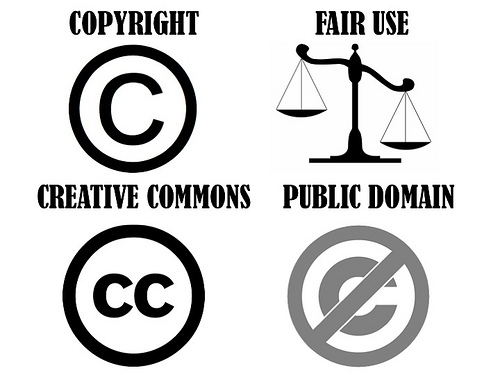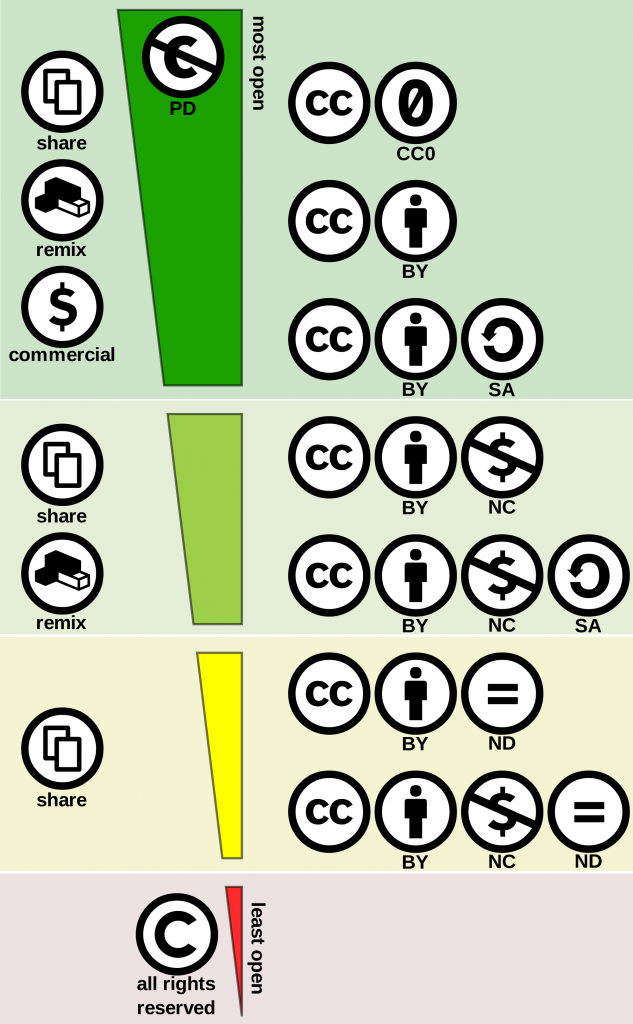Content Rights
Bay Path University takes very seriously the matter of the rights to use materials. Not all resources on the web or in print can be used freely in our course design projects. Knowing what can and cannot be used is an important part of every project.
The following are key concepts to know when working with content rights: copyright, fair use, creative commons, and open educational resources. Each will be described in greater detail below.
Copyright Law
Copyright law has been established to balance the rights of an author of a piece of work and of the public interest. An author/creator is protected in the event that his or her work is:
- Fixed – it has been turned into a tangible medium that can be read, seen, or heard
- Original – it is an original and independent creation of the author
- Creative – it required at least a minimal level of creativity to produce
Right holders are protected by law as the only ones who can reproduce their work, make and distribute copies, and share the work publicly. There are a few exceptions to these protections:
- You can request from the author rights to the work
- The right may have expired. In that case, the work is in the public domain and can be used freely
- You may have some rights to fair use since your purpose is to educate students. Read on to learn more about fair use
- The author may have given up certain rights. Read on to learn more about Creative Commons (CC) and open educational resources (OER)
Fair Use
Fair use is a set of exceptions to the protections laid out in copyright law that extends to education. Determining if your use is “fair” includes a four-step test outlined below. All four steps should be considered when determining a holistic “score” of fairness of your use.
- Purpose: What is the purpose of your use? We are a non-profit institution aimed at educating students, so we pass this test
- Nature of the Work: What is the nature of the work to be used? If the work is factual in nature – scholarly, scientific, technical – it is more likely to be used fairly in our setting. Use of creative works – fiction, plays, poems, etc. – is less likely to be fair
- Quantity: How much do you intend to use? The less of the work to be used, the more likely it is to be fairly used. A common guideline, though not written in law, is to use 10% or less of a work
- Market Effect: What is the effect on the market for the work? If the work will be used widely over time and this negatively impacts the sales market for the right holder, then your use would not be fair. In other words, if hundreds of our students can skip purchasing a work, then this would not be fair. We must be very careful of this impact even though we are a non-profit institution
Note that reproducing textbooks and course packs, even in small amounts, is almost never fair use. Pearson, McGraw-Hill, Wiley, Cengage, and other major publishers are very strict in this regard.
The library can assist in determining if your use is “fair.” You can also try a self-service fair use evaluator. This tool provides the option to read more about each of the central questions in determining fair use. In most cases, though, it is best to try to find works with Creative Commons licenses that give up many protections of copyright. Read on to learn about Creative Commons.
A Note About Websites
When considering an article or resource from a website for use in your course, take extra care!
Just because you can freely access a website from your personal computer on the internet does not necessarily mean we can use it in our course.
Search the website for any information about sharing or linking policies or educational use. If nothing is clearly stated within the main body of the article or website, scroll down to the bottom and look for links titled something like “Terms of Use” or “Copyright Information”.
It can get very confusing, but we’re here to help! If you have any questions or concerns about a resource you’ve identified, consult with your Instructional Designer or Program Director.
Creative Commons
Creative Commons (CC) is an organization that has created a set of licenses that copyright holders can provide to prospective users. Each license carries certain terms that, when followed, allow different types of usage that traditional copyright protections would otherwise restrict. CC materials are your best bet for use in a course design project.
Here are the four different terms to CC licenses that can be combined in 6 ways:
- BY – you provide attribution to the original author
- SA – you agree to release rights to works you derived in part or whole from existing CC materials
- NC – you use the work for non-commercial purposes
- ND – you use the work in its original form without editing, remixing, etc.
These terms can be combined in the following ways, from least restrictive to most:
- BY
- BY-SA
- BY-NC
- BY-SA-NC
- BY-ND
- BY-NC-ND
You can usually tell if a work has a CC license because its CC tag will be displayed somewhere within the work, typically in the footer. The CC tags look like this:
Google and YouTube each provide a search result filter that will show you only materials with CC licenses.
Rather than learn the filter technique in each search engine, though, an easier way to conduct your searches would be to use the CreativeCommons Search tool. Click on the search engine you want to use, enter your search terms, check the option for “use for commercial purposes,” and hit enter. All results have a CC license and can be used in your course design project.
Note the following visual that shows different types of licenses. Please remember that the level of attribution or request needed to use materials may vary based on how the material is licensed.
Want to learn more?
Learn more about fair use in this chapter from Copyright Overview (NOLO) provided through Stanford Libraries.
Not sure if your use would be considered fair under copyright laws? Check out this fair use evaluator to help you determine whether or not you can use a particular source.

